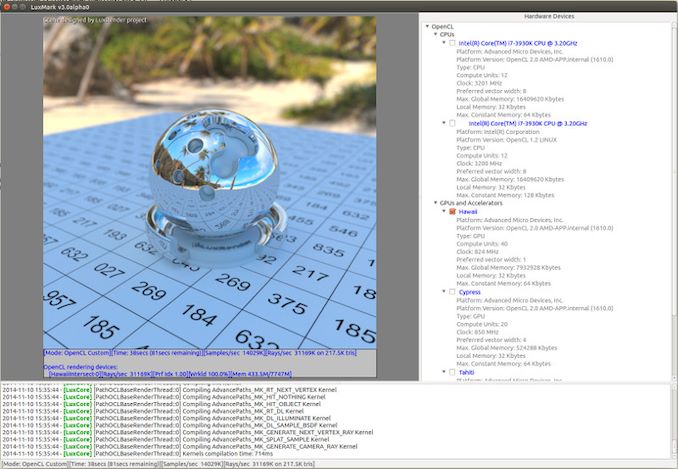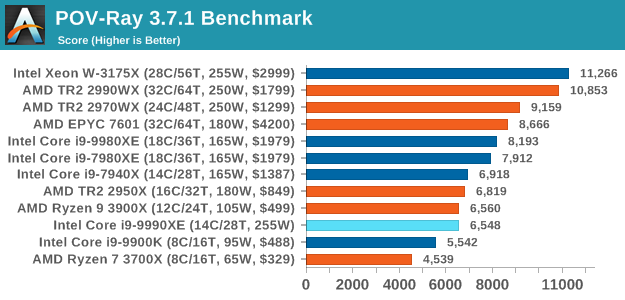The Intel Core i9-9990XE Review: All 14 Cores at 5.0 GHz
by Dr. Ian Cutress on October 28, 2019 10:00 AM ESTCPU Performance: Rendering Tests
Rendering is often a key target for processor workloads, lending itself to a professional environment. It comes in different formats as well, from 3D rendering through rasterization, such as games, or by ray tracing, and invokes the ability of the software to manage meshes, textures, collisions, aliasing, physics (in animations), and discarding unnecessary work. Most renderers offer CPU code paths, while a few use GPUs and select environments use FPGAs or dedicated ASICs. For big studios however, CPUs are still the hardware of choice.
All of our benchmark results can also be found in our benchmark engine, Bench.
Blender 2.79b: 3D Creation Suite
A high profile rendering tool, Blender is open-source allowing for massive amounts of configurability, and is used by a number of high-profile animation studios worldwide. The organization recently released a Blender benchmark package, a couple of weeks after we had narrowed our Blender test for our new suite, however their test can take over an hour. For our results, we run one of the sub-tests in that suite through the command line - a standard ‘bmw27’ scene in CPU only mode, and measure the time to complete the render.
Blender can be downloaded at https://www.blender.org/download/

Blender can take advantage of more cores, and whule the frequency of the 9990XE helps compared to the 7940X, it isn't enough to overtake 18-core hardware.
LuxMark v3.1: LuxRender via Different Code Paths
As stated at the top, there are many different ways to process rendering data: CPU, GPU, Accelerator, and others. On top of that, there are many frameworks and APIs in which to program, depending on how the software will be used. LuxMark, a benchmark developed using the LuxRender engine, offers several different scenes and APIs.

Taken from the Linux Version of LuxMark
In our test, we run the simple ‘Ball’ scene on both the C++ and OpenCL code paths, but in CPU mode. This scene starts with a rough render and slowly improves the quality over two minutes, giving a final result in what is essentially an average ‘kilorays per second’.

We see a slight regression in performance here compared to the 7940X, which is interesting. I wonder if that 2.4 GHz fixed mesh is a limiting factor.
POV-Ray 3.7.1: Ray Tracing
The Persistence of Vision ray tracing engine is another well-known benchmarking tool, which was in a state of relative hibernation until AMD released its Zen processors, to which suddenly both Intel and AMD were submitting code to the main branch of the open source project. For our test, we use the built-in benchmark for all-cores, called from the command line.
POV-Ray can be downloaded from http://www.povray.org/











145 Comments
View All Comments
edzieba - Thursday, October 31, 2019 - link
An ASIC has a significant (many months to years) lead time between "we need X design" and functioning silicon. Trading algorithms are a constant arms race being updated to counter others' algorithm changes (who then counter your counters, etc) on the days to hours timescales.shtldr - Tuesday, October 29, 2019 - link
If you've got all the money (which you should, in case you are a successful algorithmic trader), why not go ASIC?Dribble - Monday, October 28, 2019 - link
It's not as simple as you need hundreds of threads or you need one. Compiling is an obvious example. You have a mixture of tasks - some take more threads (e.g. you have a large number of files in a makefile you can compile at once), some take less threads (you have a smaller makefile with only a few files), some take one thread (you need to link).A chip like this with 14 cores and very high single thread performance it turns out is ideal for this sort of task.
Compiling is very much not a niche market.
eek2121 - Monday, October 28, 2019 - link
Word (in the article) is that it helps with web browsing as well. So there is that. ;)That being said, I don't look at this CPU as being competitive to AMD offerings simply because you can't buy the thing. However it is nice to see that Intel can do something if they put their mind to it.
bananaforscale - Thursday, October 31, 2019 - link
Well, multiple cores *do* help with web browsing, doesn't mean you need 14@5 GHz. :DMattZN - Tuesday, October 29, 2019 - link
You don't need all those cores running on a single platform to do HFT. In fact, that winds up being a negative because all the cores are competing for memory cycles. Instead what you want to do is mirror (not split, but do a full mirror) the packet stream to a whole bunch of platforms with fewer cores which can then maximally leverage their memory bandwidth and CPU caches. You also filter the packets inside the NIC itself, not with the CPU.You also don't need to have a high-frequency CPU to minimize response time. The CPU is calculating outcomes from likely moves way ahead of time, long before actually receiving any packet telling it what movement actually happened. When the packet comes in, the CPU really only needs to look up the appropriate response from a table that has already been calculated. In fact, the NIC itself could do the table lookup for certain actions and bypass the CPU entirely.
So you want lots of cores, but they don't actually have to be ultra fast. Anyone using something like this processor to try to 'get ahead' in the HFT game is going to be in for a big surprise.
-Matt
Spunjji - Wednesday, October 30, 2019 - link
Thanks for the clarification. I thought that leaning on a single, many-core high-frequency CPU for this sort of task sounded a lot like optimising the wrong part of the whole process.peevee - Monday, October 28, 2019 - link
That's the point. It does not make them much money, the volume is simply not there. It is for INTEL's bragging.eek2121 - Monday, October 28, 2019 - link
They likely auction the chips due to the aggressive binning required. I expect if they could roll out this kind of chip easily, they would have already. Think: 10 chips for every 100,000 can do 4-5 GHz @ 14 cores, 255 watt TDP.lazarpandar - Monday, October 28, 2019 - link
So if you have an absurd amount of money and can't scale with more cores beyond 14...What a stupid product.